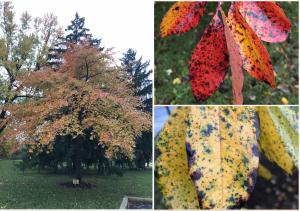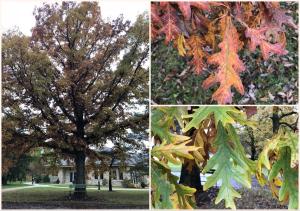
This is a post from our archives republished for fall, 2025.
Fall color is on the way at Mount St. John. The subtler sensory clues of change – the softening light, the disappearing stillness, the gradual diminuendo of the nightly insect symphony until only the final cadences register on attentive ears, will soon be overwhelmed by bursts of color. Change, ever constant, suddenly seeks and finds our attention. Fall is not, of course, an ending; nor is it a beginning. It may herald the end of tomato plants and baseball and the beginning of school and football. For the trees, though, who proclaim the stability of change and who by degrees draw our gaze further than does Summer’s pressing fecundity, fall is continuity. It is a warranty against the narrow pass of winter, an inhaling of resources and a paring to scale.
The spinning color wheel is mesmerizingly practical. The carotenoids that tint leaves yellow were there all along, hidden beneath the green chlorophyll that transforms sunlight into food. As the days shorten photosynthesis loses its energetic edge and the tree begins recycling. The components of chlorophyll – namely nitrogen – are expensive and throwing it away is foolish, except for species capable of fixing their own nitrogen. These species, locust being a prime exasmple, shower the ground extravagantly with limp, still-green leaves.
Anthocyanins gift us reds and purples and are produced only in autumn by certain trees, perhaps as a transitional shield against damaging photons of light which are normally intercepted by retreating chlorophyll. Look carefully at the color distribution in individual sugar maples in your neighborhood. Their southern faces often blush in the brighter sun. Note, too, the patterns within individual leaves. Various combinations and concentrations of our three principle players – chlorophyll, carotenoids and anthocyanins – produce striking variability between even neighboring leaves. Also, damage endured during the year may appear as brown spots, the tunnels of leaf miners – mostly larval moths or flies – are highlighted by contrast, and veins are more conspicuous.
Once all the valuable resources the tree can reclaim have been stored away for later use, an abscission layer forms at the point at which leaf attaches to twig and gravity takes over, drawing the empty, disposable, compostable packaging for a season’s worth of biochemical processes to earth. Dead? Perhaps. But spent leaves are habitat for over-wintering insects, food for fungi and other decomposers, and compost that holds moisture and conditions soil. (Public service announcement: Leave your leaves.)

Or, the leaves hang on through winter. This is known as marcescence and is most prominent in our area among the oaks, beeches, and witch hazels. Marcescence is a juvenile trait, being more common in younger trees and branches. The adaptive benefit, if one exists, of retaining instead of shedding leaves is unknown. It may discourage herbivory or protect buds from desiccation. Persistent leaves may catch and accumulate snow, adding valuable moisture to a tree’s root zone.
Although leaf senescence is more about life than death, autumn does prompt thoughts of letting go – spiritually or materially - and transitions and mortality. It did for Harlem Renaissance poet Esther Popel Shaw, who wrote October Prayer in 1933. I leave you with her hope-filled longing.
Change me, Oh God,
Into a tree in autumn
And let my dying
Be a blaze of glory!
Drape me in a
Crimson, leafy gown,
And deck my soul
In dancing flakes of gold!
And then when Death
Comes by, and with his hands
Strips off my rustling garment
Let me stand
Before him, proud and naked,
Unashamed, uncaring,
All the strength in me revealed
Against the sky!
Oh, God
Make me an autumn tree
If I must die.




